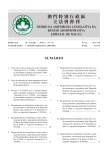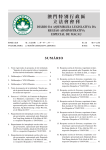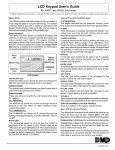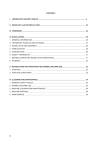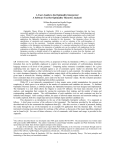Download Lvn De Novo Board Game User Manual [VER 1.0]
Transcript
Lvn De Novo Board Game User Manual [VER 1.0] I. INTRODUCTION Turns II. VALID ACTIONS Lvn Denovo Board Game is a turn based twocampaigns-multipleplayers board game. Each player controls an IMVU avatar to execute their plots in order to win a game play. This is a variant of a Levin Kuok’s invention in 1996. In a game play, the attacking campaign shall make the initial move. Players in a campaign take action(s) following the prearrange order. After all players in a campaign finish their actions, the other campaign begins their action. In each turn, all avatars & dominated district must act once unless freeze. An avatar can act twice if it involves in a group action. Singleton Actions Game Pieces Host campaign is formed by 1 avatar (room owner) & a group of stone pieces (5 x guest campaign’s avatar numbers). Guest campaign, an invited campaign, is a group of avatars (1 – 5). Domination The game board has 9 districts separated with bold lines. Each district has 3 x 3 squares which are separated with thin lines. Origin is a special center point that only an avatar can stand on. Whenever a campaign has more pieces over another campaign in a district, this campaign is said to be the dominant of this particular district from the next turn. If both campaigns have same amount of pieces in a certain district, it is a draw or freeze. If a district contains no pieces, it is unoccupied. Freeze & lost of domination has immediate effects after action. Arrangement Winner (Goal) In the initial stage, the defensive campaign’s stone pieces are arranged within the inner circular districts. Where by, the attacking campaign’s pieces are places within the outer districts. The host campaign can choose to be attacking side or defensive side. In a certain stage (end of a turn of single campaign), where by all occupied district has the same campaign as dominant, this campaign becomes the winner of the game play. Guest campaign becomes winner if the host campaign’s avatar is removed. Game Board A singleton can be an avatar or a single stone piece. It can move, eliminate, and charge. i) Move & Slide A singleton can move vertically or horizontally to its adjacent square. Diagonal move is not allowed. An avatar is allowed to move along a direction and stop at any square the player wishes. This is also called a slide. It has to stop to do elimination if it encounters an enemy piece. ii) Eliminate A singleton can replace an enemy piece when it moves to the enemy piece located square. Enemy piece is then removed from board. Invented by Levin Kuok in 1996. IMVU variant Implemented in 2008. Lvn De Novo Board Game User Manual [VER 1.0] iii) Charge A charge is done when a singleton crosses over an adjacent enemy piece. The enemy piece has to be removed. A singleton can do a continuous charging in 1 turn and remove multiple enemy pieces. Continuous charging is considered as a single action. Group Actions When a campaign is the dominant of a district contains 2 pieces or above, these pieces are allowed to do a group action. These actions including, marching, merging, splitting, rearranging, charging, invading, and initiate a simultaneous group attack. i) Marching All pieces in a dominated district move to another district. Each piece is located at the corresponding square. ii) Merging A dominated district piece can request the nearby district’s pieces to merge into its district if those pieces in another district have corresponding space square. iii) Splitting A dominated district’s pieces can partly split into another unoccupied district provided that it doesn’t lose the domination of the original district. Gaining the domination of target district is allowed. iv) Rearranging Within a dominated district, all pieces of the dominant campaign can be relocated freely. v) Charging A dominated district’s pieces cross over a district and reach the opposite district along the same direction. Each corresponding square has done a crossing charge to eliminate opponent’s pieces in mass. vii) Invade A dominated district dump the pieces into another district contains opponent pieces in force. Where by all the corresponding squares are replaced by the initiator. vii) Simultaneous attack A dominated district invade a district contains opponent pieces together with other dominated district nearby opponent’s district. The district tat initiate this attack must contains an avatar. Invented by Levin Kuok in 1996. IMVU variant Implemented in 2008. Lvn De Novo Board Game User Manual [VER 1.0] ii) Freeze Freeze is a consequence at the end of any action. After any action, if a district contains same amount of pieces from both campaigns. It is a freeze. None of the avatars or pieces in it is allowed to move by themselves. To unlock a freeze, you may break the force balance by invade in, charging through, or drag your pieces out by merging. III. CONSEQUENCES i) Capture Capture is a consequence that should be justified at the end of any actions. When a piece is surrounded by opponents in both vertical & horizontal directions, it has to be removed from board. Multiple captures are allowed to be done together. IV. BASIC TACTICS Here we list down some example basic tactics: i)Repeat splitting to dominate more districts. ii)Rearrange to make a capture. iii) Charge and catch. iv)Rearrange for a better formation to charge. v)Do a merge to extract the piece in a freeze district. vi)Make a freeze & arrange a kill. An example is illustrated by the following diagrams. Invented by Levin Kuok in 1996. IMVU variant Implemented in 2008.




